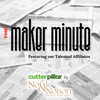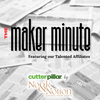You Spin Me Right-Round Baby, Right-Round, Like a Record Baby...

Lets just say that the CutterPillar Swivel Rotating Cutting Mat will out perform and last much longer than this guy. Unless it's at a 1985 Homecoming Dance. :) (Sorry, there are so few songs about spinning... and none about swiveling!)
Wow... that may be too era-specific of a joke and very corny to-boot, but can I get a virtual high-five from all the Gen-Xers out-there?!?
When we started designing the CutterPillar Swivel, we had a lot of competitors and models to draw inspiration from. We new the "why". We just need the the "what" and "how". The old adage: "to build a better mousetrap". That was the motivator. But before we get into that... lets discuss the "why". For those who have never used a rotating mat to cut shapes.
Using a quilter's rotating cutting mat offers several advantages when cutting out shapes. It allows you to rotate the mat while keeping the fabric stationary, providing greater precision and control over the cutting process. This feature is particularly beneficial when cutting intricate shapes or patterns that require multiple cuts from different angles. Additionally, the rotating surface helps reduce fabric distortion and shifting, ensuring accurate cuts. The non-slip backing of these mats also helps keep the fabric in place during cutting, further enhancing accuracy. Overall, a quilter's rotating cutting mat provides a stable, secure, and versatile surface for precise fabric cutting, making it an invaluable tool for quilters, crafters, and anyone working with textiles.
Okay, now the "why" is buttoned up. Let's explore and see if our "what" and "how" can stand up to compare to a very crowded rotating-mat market.
We started with what we didn't want:
- Too much spinning?:We knew thatmats spinning-on-mats was the wrong way to start. On the lower end of the rotating mat market is the PVC spinning on PVC. Sure they work great right out of the box... but more they get used, the more likely the PVC breaks down and dirt and fabric dust gets between the layers. And then one morning you start to spin your mat, it locks-up and knocks your coffee over! This design fails ultimately. We wanted something better, and that better was...
-
Ball bearings! Whomever first thought of this was truly inspired. Rotating on ball bearings between the layers was the game-changer. Sorta like cave-men figuring out that wheels made it much easier to move their wives around; vs just dragging them through the dirt by their hair. (wait, what... cave-man jokes? Yikes) So like enlightened cave-men, we added ball-bearings to the Swivel.
- Ball bearings! Whomever first thought of this was truly inspired. Rotating on ball bearings between the layers was the game-changer. Sorta like cave-men figuring out that wheels made it much easier to move their wives around; vs just dragging them through the dirt by their hair. (wait, what... cave-man jokes? Yikes) So like enlightened cave-men, we added ball-bearings to the Swivel.
Mat-life: Another aspect of many of the other rotating mats out there is fact that many of them glue their cutting mat to the rotating top. Which means: when that mat gets cut-up and/or worn out... the whole thing has to be replaced. You now have a $80 paper weight. Or... you can put it under a Scrabble Game board for your "triple-word-scoring"!!

-

See you on the flip-side: Not only is the CutterPillar Swivel's mat replaceable, but we also made it twice as thick too. Which allows for cutting on both sides of the mat. If using grid, cut on he top side. If using a acrylic template, cut on the reverse side. The Swivel mat is held in place by gravity in molded tray on its top side. If using a acrylic template, cut on the reverse side. The Swivel mat is held in place by gravity in its molded tray. You can easily flip it top-to-bottom.
- To see or not to see: CutterPillar products are known for getting the light to where it's needed. So naturally we built a terribly-complicated rotating base that had built-in LEDs to illuminate the rotating mat. It was going to be expensive and sometimes it spontaneously caught on fire!! (not really). But it was expensive and overelaborate. Then we had one of those "ah-ha" moments!! We ditched the LED's and the electronic board and just made the whole Swivel translucent. It took us an embarrassingly long 3-4 months to realize we already had LEDs in our Glow lightboards...duh! Just put any low-profile light-board/box under the Swivel and... voila! The whole spinning/cutting space is flooded with light from underneath. Shinning through most fabrics and patterns. Best of all... no shadows while leaning-in close plan and cut those shapes out.
-
Lastly, finger-tips look better on your fingers: One of the short-comings of a mat that spins on ball bearings is... using a razer sharp rotary-blade on a surface that can't not spin!! (I know, I know... that's a double-negative, can't not just sounds better) All the ball bearing mats out there rotate whether you want them to or not. Making most cutting on this spinny-mat a dangerous endeavor.

- Here at CutterPillar we have grown fond of our fingers, and wanted to keep them intact. So we figured something out: We moved the ball bearings from the outside of the diameter to the center. This move allow some flex in the board. Meaning, when cutting pressure is applied, the outer diameter is pushed down, thus stopping the mat from rotating!! To aid in this, we also added silicone feet all around the outside edge to help stop the spin while cutting.

So there you have it... the why, what and how, to build a better mouse-trap. We like it and think its very good at its job. But don't take our word for it. Below is a terrific YouTube review from Francis Quilts





